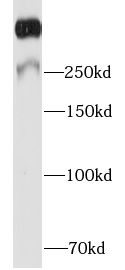GSK3B antibody - 100 µg
Host : Rabbit
Clonality: Polyclonal
Clone:
Isotype: IgG
Immunogen: glycogen synthase kinase 3 beta
Purity: ≥95% as determined by SDS-PAGE
Form: Liquid
Molecular weight: 50 kDa
Uniprot: P49841
Gene id: 2932
Background: Constitutively active protein kinase that acts as a negative regulator in the hormonal control of glucose homeostasis, Wnt signaling and regulation of transcription factors and microtubules, by phosphorylating and inactivating glycogen synthase(GYS1 or GYS2), EIF2B, CTNNB1
beta-catenin, APC, AXIN1, DPYSL2
CRMP2, JUN, NFATC1
NFATC, MAPT
TAU and MACF1. Requires primed phosphorylation of the majority of its substrates. In skeletal muscle, contributes to insulin regulation of glycogen synthesis by phosphorylating and inhibiting GYS1 activity and hence glycogen synthesis. May also mediate the development of insulin resistance by regulating activation of transcription factors. Regulates protein synthesis by controlling the activity of initiation factor 2B(EIF2BE
EIF2B5) in the same manner as glycogen synthase. In Wnt signaling, GSK3B forms a multimeric complex with APC, AXIN1 and CTNNB1
beta-catenin and phosphorylates the N-terminus of CTNNB1 leading to its degradation mediated by ubiquitin
proteasomes. Phosphorylates JUN at sites proximal to its DNA-binding domain, thereby reducing its affinity for DNA. Phosphorylates NFATC1
NFATC on conserved serine residues promoting NFATC1
NFATC nuclear export, shutting off NFATC1
NFATC gene regulation, and thereby opposing the action of calcineurin. Phosphorylates MAPT
TAU on 'Thr-548', decreasing significantly MAPT
TAU ability to bind and stabilize microtubules. MAPT
TAU is the principal component of neurofibrillary tangles in Alzheimer disease. Plays an important role in ERBB2-dependent stabilization of microtubules at the cell cortex. Phosphorylates MACF1, inhibiting its binding to microtubules which is critical for its role in bulge stem cell migration and skin wound repair. Probably regulates NF-kappa-B(NFKB1) at the transcriptional level and is required for the NF-kappa-B-mediated anti-apoptotic response to TNF-alpha(TNF
TNFA). Negatively regulates replication in pancreatic beta-cells, resulting in apoptosis, loss of beta-cells and diabetes. Through phosphorylation of the anti-apoptotic protein MCL1, may control cell apoptosis in response to growth factors deprivation. Phosphorylates MUC1 in breast cancer cells, decreasing the interaction of MUC1 with CTNNB1
beta-catenin. Is necessary for the establishment of neuronal polarity and axon outgrowth. Phosphorylates MARK2, leading to inhibit its activity. Phosphorylates SIK1 at 'Thr-182', leading to sustain its activity. Phosphorylates ZC3HAV1 which enhances its antiviral activity. Phosphorylates SNAI1, leading to its BTRC-triggered ubiquitination and proteasomal degradation. Phosphorylates SFPQ at 'Thr-687' upon T-cell activation. Phosphorylates NR1D1 st 'Ser-55' and 'Ser-59' and stabilizes it by protecting it from proteasomal degradation. Regulates the circadian clock via phosphorylation of the major clock components including ARNTL
BMAL1, CLOCK and PER2. Phosphorylates CLOCK AT 'Ser-427' and targets it for proteasomal degradation. Phosphorylates ARNTL
BMAL1 at 'Ser-17' and 'Ser-21' and primes it for ubiquitination and proteasomal degradation. Phosphorylates OGT at 'Ser-3' or 'Ser-4' which positively regulates its activity. Phosphorylates MYCN in neuroblastoma cells which may promote its degradation(PubMed:24391509).
Field of research: Signal Transduction, Metabolism, Cardiovascular, Immunology, Developmental biology, Neuroscience, Cell Division and Proliferation
Storage conditions: PBS with 0.02% sodium azide and 50% glycerol pH 7.3, -20°C for 12 months(Avoid repeated freeze
thaw cycles.)
Applications: ELISA, WB, IF, IHC, FC
Dilution: WB: 1:500-1:2000; IHC: 1:20-1:200; IF: 1:20-1:200
Target: GSK3B
Purification: Immunogen affinity purified
Reactivity: Human, Mouse

Clonality: Polyclonal
Clone:
Isotype: IgG
Immunogen: glycogen synthase kinase 3 beta
Purity: ≥95% as determined by SDS-PAGE
Form: Liquid
Molecular weight: 50 kDa
Uniprot: P49841
Gene id: 2932
Background: Constitutively active protein kinase that acts as a negative regulator in the hormonal control of glucose homeostasis, Wnt signaling and regulation of transcription factors and microtubules, by phosphorylating and inactivating glycogen synthase(GYS1 or GYS2), EIF2B, CTNNB1
beta-catenin, APC, AXIN1, DPYSL2
CRMP2, JUN, NFATC1
NFATC, MAPT
TAU and MACF1. Requires primed phosphorylation of the majority of its substrates. In skeletal muscle, contributes to insulin regulation of glycogen synthesis by phosphorylating and inhibiting GYS1 activity and hence glycogen synthesis. May also mediate the development of insulin resistance by regulating activation of transcription factors. Regulates protein synthesis by controlling the activity of initiation factor 2B(EIF2BE
EIF2B5) in the same manner as glycogen synthase. In Wnt signaling, GSK3B forms a multimeric complex with APC, AXIN1 and CTNNB1
beta-catenin and phosphorylates the N-terminus of CTNNB1 leading to its degradation mediated by ubiquitin
proteasomes. Phosphorylates JUN at sites proximal to its DNA-binding domain, thereby reducing its affinity for DNA. Phosphorylates NFATC1
NFATC on conserved serine residues promoting NFATC1
NFATC nuclear export, shutting off NFATC1
NFATC gene regulation, and thereby opposing the action of calcineurin. Phosphorylates MAPT
TAU on 'Thr-548', decreasing significantly MAPT
TAU ability to bind and stabilize microtubules. MAPT
TAU is the principal component of neurofibrillary tangles in Alzheimer disease. Plays an important role in ERBB2-dependent stabilization of microtubules at the cell cortex. Phosphorylates MACF1, inhibiting its binding to microtubules which is critical for its role in bulge stem cell migration and skin wound repair. Probably regulates NF-kappa-B(NFKB1) at the transcriptional level and is required for the NF-kappa-B-mediated anti-apoptotic response to TNF-alpha(TNF
TNFA). Negatively regulates replication in pancreatic beta-cells, resulting in apoptosis, loss of beta-cells and diabetes. Through phosphorylation of the anti-apoptotic protein MCL1, may control cell apoptosis in response to growth factors deprivation. Phosphorylates MUC1 in breast cancer cells, decreasing the interaction of MUC1 with CTNNB1
beta-catenin. Is necessary for the establishment of neuronal polarity and axon outgrowth. Phosphorylates MARK2, leading to inhibit its activity. Phosphorylates SIK1 at 'Thr-182', leading to sustain its activity. Phosphorylates ZC3HAV1 which enhances its antiviral activity. Phosphorylates SNAI1, leading to its BTRC-triggered ubiquitination and proteasomal degradation. Phosphorylates SFPQ at 'Thr-687' upon T-cell activation. Phosphorylates NR1D1 st 'Ser-55' and 'Ser-59' and stabilizes it by protecting it from proteasomal degradation. Regulates the circadian clock via phosphorylation of the major clock components including ARNTL
BMAL1, CLOCK and PER2. Phosphorylates CLOCK AT 'Ser-427' and targets it for proteasomal degradation. Phosphorylates ARNTL
BMAL1 at 'Ser-17' and 'Ser-21' and primes it for ubiquitination and proteasomal degradation. Phosphorylates OGT at 'Ser-3' or 'Ser-4' which positively regulates its activity. Phosphorylates MYCN in neuroblastoma cells which may promote its degradation(PubMed:24391509).
Field of research: Signal Transduction, Metabolism, Cardiovascular, Immunology, Developmental biology, Neuroscience, Cell Division and Proliferation
Storage conditions: PBS with 0.02% sodium azide and 50% glycerol pH 7.3, -20°C for 12 months(Avoid repeated freeze
thaw cycles.)
Applications: ELISA, WB, IF, IHC, FC
Dilution: WB: 1:500-1:2000; IHC: 1:20-1:200; IF: 1:20-1:200
Target: GSK3B
Purification: Immunogen affinity purified
Reactivity: Human, Mouse

